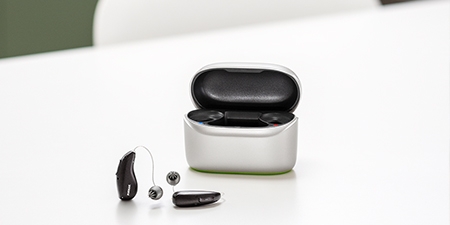Sensorineural vs. Conductive Hearing Loss

Sensorineural vs. Conductive Hearing Loss
5 min
Published December 23, 2024
Sensorineural Hearing Loss
This type of hearing loss occurs when the inner ear or nerve pathways connected to the brain become damaged. Sensorineural hearing loss is the most common type of permanent hearing loss.Causes
- Aging
- Prolonged or repeated exposure to loud noises
- Underlying medical conditions, such as heart disease, diabetes, acoustic neuroma, or an autoimmune disease
- Traumatic inner ear injuries
- Genetic syndrome or infection passed from mother to fetus, resulting in a baby being born with hearing loss
Symptoms
Sensorineural hearing loss affects both the loudness and clarity of sounds. Many people experience high-frequency hearing loss first, making speech and high-pitched sounds more difficult to hear. Conversations may sound slurred or mumbled, creating the feeling that you can hear but not understand.
Treatment
The most common treatment for sensorineural hearing loss is to wear hearing aids. Cochlear implants are another option for severe auditory impairment. Assistive listening devices such as vibrating alarm clocks and captioned telephones provide additional hearing solutions.
Conductive Hearing Loss
This is a less common and often temporary type of hearing loss. It occurs when sounds don’t travel effectively through the ear canal due to an obstruction or damage to the outer or middle ear.
Causes
- Ear infections
- Wax buildup
- Swimmer’s ear
- Foreign objects inserted into the ear
- Stenosis (narrowing of the ear canal)
- Exostoses (bone-like protrusions in the ear canal)
Symptoms
Because the auditory nerve and sensitive inner ear are intact, conductive hearing loss usually makes noises less loud but not muddled. As a result, simply turning up the volume may help improve hearing. Other symptoms may include pain or pressure, hearing loss in only one ear, or feeling like your voice sounds different.
Treatment
Conductive hearing loss is often reversed by treating the specific cause, such as extracting earwax, taking antibiotics, or having surgery. However, some causes, such as stenosis or exostoses, are more difficult to treat and may cause permanent hearing loss. In this case, hearing aids are often recommended.
Mixed Hearing Loss
Mixed hearing loss is a combination of sensorineural and conductive hearing loss. It can occur suddenly following a traumatic event or develop gradually when one type of hearing loss compounds the other. The symptoms are a mix of those listed for the conditions above. Treatment depends on whether the hearing loss is more sensorineural or conductive in nature.
No matter the type or cause of your hearing loss, we invite you to schedule a free hearing test and consultation with AudioNova. We offer 30-day, risk-free hearing aid trials, so you can test out some of the world’s best hearing devices at no cost and no obligation—no kidding! For more information, please call 888-845-7931 or contact us online. You’ll be glad you did!




